Advantages of vacuum furnace technologies for heat treating extrusion dies
Case History: Advantages of vacuum furnace technologies for heat treating extrusion dies
Author
 Don Marteeny, Vice President/Engineering
Don Marteeny, Vice President/Engineering
don.marteeny@secovacusa.com
SECO/VACUUM, a SECO/WARWICK Group Company
As published in the April 2022 issue of Light Metal Age
Quenching is critical to heat treating quality
H-Series tool steels used in the manufacturing of extrusion dies are easily hardenable and if the cross-sectional thickness is thin enough (typically less than 1-2”), can even be air hardened. However, when cross-sectional thickness increases (typically >2”), air cooling loses its effectiveness when through-hardening H-series tool steel components.
There are, of course, several different quench techniques available for hardening. Of these, oil quenching is not preferred because of the steel alloy’s susceptibility to distortion and the risk of cracking. Air quenching is also not preferred, because of its slower cooling rate, which does not allow the core to cool quickly enough to reach the desired hardness. Also, the surface of the die will oxidize as it reacts with the O2, leading to further downstream manufacturing processes.
In a fluidized bed heat treatment system, dies are held in a furnace filled with sand, and the sand is heated while nitrogen flows through the sand, providing both conduction and convection heating to the components. This method provides excellent heat distribution through the dies in an inert atmosphere. However, in fluidized bed systems, the hot dies are usually removed to air cool, producing potential issues with distortion and surface finish quality. Meanwhile, loose sand that falls from the dies and fixturing during the fixture removal process tends to cover the equipment and facility.
A potential solution to this issue involves moving the hardening process to a vacuum heat treatment furnace (Figure 1). This article will provide an overview of vacuum furnaces and advice for upgrading to such a system.
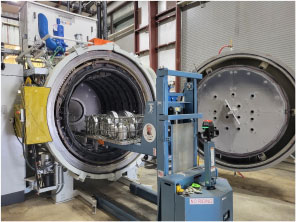 |
| Figure 1. A single chamber HPGQ vacuum heat treat furnace. (Photo: Youngstown Tool & Die.) |
Vacuum heat treatment furnaces produce the necessary through-hardening to the die’s core with very little distortion. There are many different types of vacuum furnaces, including single and multi-chamber, batch, and continuous. However, the most common in the extrusion die industry is the single chamber design with an integral high-pressure gas quenching (HPGQ) system, with pressures as high as 6 bar and up.
Since heat treatment takes place in a vacuum environment and quenching also occurs in an inert nitrogen gas environment, the steel dies are never exposed to the air until after they are completely quenched and removed from the vacuum chamber. This ensures that the dies are clean with no oxidation. Eliminating surface oxidation can minimize the need for machining after heat treating as opposed to the air or oil cooling processes.
Single chamber HPGQ vacuum furnaces are available in both horizontal (front loading) and vertical configurations, with the most common type being a horizontal, front-loading design. In these types of furnaces, numerous dies can be batched within basket fixtures that are front loaded into the furnace.
Some extrusion dies are cylindrical with large length-to-width aspect ratios. For dies with this configuration, it is better to process them in a vertically configured furnace in order to accommodate the increased length, while maximizing the working volume of the hot zone. Additionally, longer and subsequently heavier parts can be handled more easily through the use of an overhead crane in a vertical chamber. The handling fixtures for vertical furnaces can accommodate multiple dies in both horizontal and vertical configurations, so that the dies are positioned for ideal thermal and quench gas flow circulation for even heating and cooling. A built-in convection fan assists in reducing heating times by promoting heat transfer in lower temperature portions of the cycle.
Typical die vacuum hardening processes are performed in a horizontally configured working zone with common chamber sizes, including 24 inches wide x 24 inches high x 36 inches deep and 36 inches wide x 36 inches high x 48 inches deep. When considering vertical configurations, common working zone sizes include 50 inches in diameter x 50 inches high and 60 inches in diameter x 60 inches high, which can handle loads up to 3,300 and 4,400 lbs, respectively. One key factor that promotes excellent quench performance is the ability to position the load close to the quench nozzles, so a smaller furnace chamber will generally assure a faster quench than a larger chamber can provide.
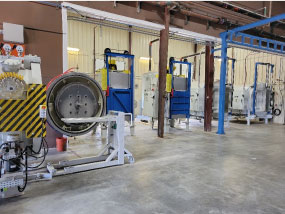 |
| Figure 2. A row of tempering furnaces positioned near to the vacuum heat treating furnace. (Photo: Youngstown Tool & Die.) |
A typical vacuum furnace cycle may last 6-8 hours or longer, depending on the material’s cross sections and load characteristics. Once removed from the chamber, all extrusion tooling must be tempered within a certain time period in a tempering furnace to achieve the correct mechanical properties. Since tempering cycle times can be two to three times the length of the hardening cycle, it may be necessary to have multiple tempering furnaces in order to handle a single HPGQ furnace load (Figure 2). In doing so, a temper is always available to accept a hardened load immediately following a hardening cycle. Add- ing to the need to have tempering available directly after hardening, dies will often require one or more temper cycles. A common rule of thumb is to have one tempering furnace for the total number of temper processes required.
Tempering furnaces are also available in both horizontal and vertical configurations. Either type can operate with air or nitrogen. A retort-style furnace can also be used in this application. It has the ability to produce components with improved surface quality, since it can be equipped with a vacuum purge used prior to tempering in a nitrogen environment. A third option is a tempering furnace that operates under a full vacuum, which virtually eliminates all oxygen from the process. This, in turn, eliminates oxidation, leaving the dies with a bright surface finish, eliminating the need to machine oxidized surfaces.
While tempering can also be accomplished in the vacuum hardening furnace, the economics do not typically support that approach, since a vacuum heat treat furnace is typically four to five times the capital cost of a separate tempering furnace. In practical applications, one vacuum furnace can produce enough throughput to feed three temper furnaces. A single vacuum furnace for both heat treatment and tempering makes sense only for very low volume throughput. Again, a good general rule is that the die maker will need at least one tempering furnace per tempering process required.
Upgrading to Vacuum Heat Treatment
Over the years, extrusion die manufacturers have gradually moved to vacuum heat treating methods from legacy fluidized bed systems, and now, it appears that the extrusion die business is moving in the same direction. Recently, a major North American extrusion die manufacturer decided to replace their older fluidized bed furnaces with vacuum heat treatment. The company ordered 11 pieces of equipment with tempering and gas nitriding technologies.
Another upgrade project involved a Midwestern die manufacturing firm, which purchased a high pressure gas quench vacuum furnace to conduct their own heat treating in-house rather than sending their dies out to a local commercial heat treater. Many more die manufacturers and extruders across North America are making similar transitions, moving from atmosphere heat treating to vacuum heat treatment.
Several factors figure into the decision-making process when considering upgrading from traditional hardening in an atmosphere furnace to hardening in a vacuum furnace. First, capital cost is by no means a minor issue. Vacuum technologies can demand many times the cost of a fluidized bed furnace or integral quench furnace and, as long as the old system is working, it may not make sense to upgrade. However, processing in a vacuum furnace eliminates costly and time-consuming maintenance typical of a fluidized bed system, as well as removing the environmental challenges of sand and dust being spread throughout the heat treatment facility. Second, vacuum heat treatment eliminates oxidation issues from quenching in air, eliminating the need for post heat treat machining or sandblasting to remove surface oxidation.
On the other hand, vacuum heat treatment is typically heated with electric power, which can cost more than a gas heated furnace. However, elimination of post heat treatment processes and quality improvements can offset the operating cost increases.
Planning the Upgrade: For companies that have an interest in upgrading but are unfamiliar with the technology, the first step is to consult with a vacuum furnace manufacturer. They will want to understand the load and product mixes to decide what types of parts can be combined in a furnace cycle, which will determine the furnace size and configuration. Once that evaluation is complete, they will look at utilities to determine what, if any, upgrades are necessary to support the new quench process. This includes the electrical capacity, the availability of nitrogen at the proper pressure, and the available cooling water systems that will be needed to keep the furnace chamber surface cool and to supply high flow water demands when needed for quenching. In addition, the manufacturer will assess and design the load handling systems (manual, powered, or automated) that need to be integrated with the furnace. Automated loading options are available that can manage the entire material handling cycle of vacuum heat treating and tempering without human interference.
For most die makers with a wide range of product loads, sizes, mix, and cross-sectional thicknesses, it can be challenging to put together a logical plan to achieve all the goals of an upgrade. With the right equipment partner, die makers can make informed decisions to effect significant improvements in productivity and efficiency of their processes using vacuum heat treatment.
Case Study: In 2020, Youngstown Tool & Die, a division of Phoenix International SpA, the largest extrusion die manufacturer in the world, upgraded their heat treatment capabilities with the installation of vacuum heat treatment furnaces. The company installed two Vector®, from SECO/VACUUM, and SECO/WARWICK Group company, which have shown good results and provided the company with a number of benefits.
“There wasn’t much of a learning curve to commission our new vacuum furnaces, and once installed, running them is very easy and straightforward,” said David Mrdjenovic, general manager of Youngstown Tool & Die. “Modern digital controls allow us to easily dial in each process recipe for very reliable repeatability, removing all of the process variability you’d expect from fluidized bed or atmosphere box furnaces.”
Another key element of the investment is that it provides the die maker with more control of the overall process parameters and outcome. “If you want to control the costs and lead times—and you want to be sure about the product quality as well—you really have to do the heat treatment yourself,” noted Mrdjenovic. “Having your own equipment, and vacuum in particular, offers you consistency from run to run. Quench cycles are so much better with a vacuum system, particularly in the way they direct the cooling nozzles inside the furnace to cool the dies with exceptional uniformity, low distortion, and zero oxidation.”


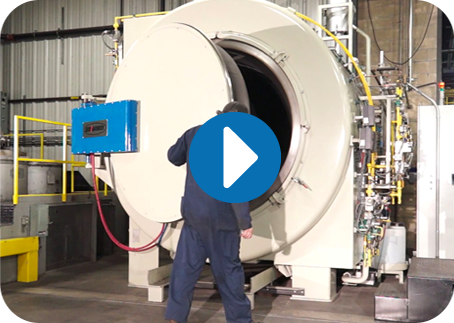 Video: Cambridge Heat Treating Puts ZeroFlow® Nitriding Process to the Test
Video: Cambridge Heat Treating Puts ZeroFlow® Nitriding Process to the Test
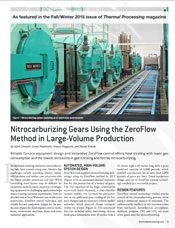 Case Study: Automaker Saves Money With High Volume Gas Nitriding/Ferritic Nitro-Carburizing System
Case Study: Automaker Saves Money With High Volume Gas Nitriding/Ferritic Nitro-Carburizing System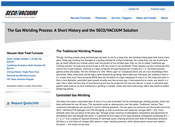 Article: Gas Nitriding, A Short History
Article: Gas Nitriding, A Short History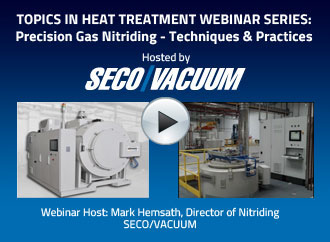 Webinar: Precision Nitriding
Webinar: Precision Nitriding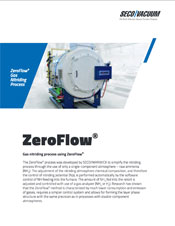 Brochure: Gas Nitriding Using the ZeroFlow® Process
Brochure: Gas Nitriding Using the ZeroFlow® Process

